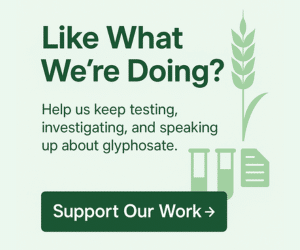Every time new research surfaces or regulators start taking a closer look at glyphosate-based weedkillers, something familiar seems to happen.
A wave of articles appears insisting that concerns about these products are overblown — that the public is reacting to fear, not facts. The tone is always the same: reassuring, dismissive, and quietly confident that any real-world questions must be driven by “scare stories.”
And if you read closely, these pieces have something in common. They’re rarely about unpacking the science itself. They’re about shaping how people feel about the science.
That’s a distinction we don’t talk about enough.
There’s science — actual evidence, emerging research, and unanswered questions. And then there’s science messaging: a curated story designed to reassure, simplify, and smooth over the uncomfortable gaps. When it comes to glyphosate-based weedkillers, that messaging leans heavily on a few familiar themes:
- that concern equals irrational fear
- that long-term exposure questions are “myths”
- that decades-old approvals are still reliable
- that the public simply needs reassurance, not information
All of this would be comforting — if New Zealand’s regulatory system had actually tested the things people are asking about.
But it hasn’t. And more people are noticing.
Which leads to the obvious question:
Are these articles truly informing the public… or simply managing the narrative?
The Pattern: How Public Concern Gets Reframed as “Fear”
If you follow public conversations about glyphosate-based weedkillers, you can almost predict the tone shift when scrutiny increases. Instead of engaging with new research or evidence gaps, the focus swings toward the people asking the questions.
Suddenly, the issue isn’t the chemical — it’s the “fear.”
Articles and social media posts begin framing concern as emotional rather than reasonable. Questions get lumped together with fringe claims. Nuance disappears. And the public is gently guided toward a simple conclusion: people are overreacting.
This reframing happens in a few predictable ways:
- Concerns become “scare stories.”
Legitimate questions get trivialised or dismissed. - Reasonable scepticism becomes “misinformation.”
Even when grounded in published science or regulatory documents. - The chemical becomes secondary.
The spotlight shifts away from the product and onto the behaviour of the public. - Industry voices are framed as neutral.
Statements from manufacturers are presented as objective corrections rather than one side of a debate.
By the time this framing settles in, anyone expressing concern is subtly positioned as misled, confused, or overly anxious. It’s quiet, but it’s effective.
And it tends to surface when something important is happening — when the evidence gets harder to ignore, when public attention rises, or when communities start asking more pointed questions.
This isn’t about hysteria.
It’s about how the conversation is shaped.
“Trust the Regulators”: The Most Common Glyphosate Deflection
Another familiar message shows up whenever glyphosate-based weedkillers are questioned: the public simply needs to “trust the regulators.”
It sounds reassuring. Most people want to believe there’s a robust system quietly verifying that products on store shelves are safe. But that assumption doesn’t match how New Zealand’s chemical approval framework actually works.
The Environmental Protection Authority does not independently test chemical products. It doesn’t collect samples, send them to labs, or verify that data reflects real-world use. Instead, regulators rely heavily — sometimes entirely — on studies provided by the manufacturers themselves.
That structure isn’t unique to New Zealand. But it does mean:
- “approval” is not the same as independent verification
- regulators assess the active ingredient, not the full formulation
- the product people buy and spray is not the product that has been tested
This isn’t a minor detail. It’s the central problem.
The Parliamentary Commissioner for the Environment has repeatedly warned that New Zealand lacks a modern, proactive system for reassessing older chemicals or monitoring their real-world impacts. Yet the “trust the system” messaging persists, as if repetition can cover the cracks.
And this is where clarity matters:
Questioning a process that hasn’t tested the full formulation isn’t anti-science.
It’s the most scientific instinct of all.
New evidence continues to emerge. Formulations change. Residues are still being detected. International regulators are moving in different directions.
In that context, the idea that New Zealanders should simply stop asking questions feels increasingly out of step with reality.
Trust isn’t the issue.
Transparency is.
What PR-Friendly “Science” Articles Leave Out
When you look closely at articles that dismiss concern about glyphosate-based weedkillers — including well-known brands such as Roundup — they tend to avoid the evidence people are actually talking about. Instead of grappling with new research, they rely on older talking points that no longer reflect the science.
This isn’t accidental. It’s strategic.
Because once you bring real-world evidence into the discussion, the narrative becomes very difficult to maintain.
These pieces rarely mention that the full formulation has never been tested for long-term safety in New Zealand. The liquid people actually spray on driveways, orchards, school grounds, and farm paddocks is not the liquid regulators assessed decades ago.
They also tend to leave out entire areas of modern research:
- formulation toxicity
- synergistic effects between ingredients
- endocrine disruption
- gut microbiome impacts
- prenatal and metabolic findings (including the July 2025 study)
- environmental persistence
- current residue findings in NZ foods
And perhaps most importantly:
They leave out the growing list of international regulatory actions — countries restricting, reassessing, or banning glyphosate-based weedkillers based on new evidence, not “scare stories.”
When you remove all of this from the picture, reassurance becomes easy.
But it is reassurance built on absence, not accuracy.
Public concern isn’t outliving the science.
The science is outpacing the messaging.
Why Reassurance Messaging About Weedkillers Is So Effective
These narratives don’t appear randomly. They surface when the traditional story about glyphosate-based weedkillers starts to slip — when public confidence wavers, when communities ask sharper questions, or when councils and retailers reconsider their herbicide policies.
This messaging isn’t designed to deepen understanding.
It’s designed to stabilise confidence.
It works because most people:
- assume someone else has checked the details
- prefer simple answers over complex realities
- believe that if something were dangerous, they’d be told
And industries have long relied on this human tendency — not just for herbicides, but for tobacco, asbestos, PFAS, neonicotinoids, and ultra-processed foods. The strategy repeats because it’s effective.
But in New Zealand, that strategy is losing traction as more people learn how chemical approvals actually work — and how many assumptions the system relies on.
New Zealand’s Chemical Approval System: Outdated and Under-Reviewed
Most New Zealanders assume our regulatory system constantly updates itself as new evidence emerges. We picture a modern, independent framework — a living process.
But the reality is different.
New Zealand’s chemical approvals were largely built decades ago, when understanding of long-term, low-dose exposure was limited. Approvals granted in the 1990s and early 2000s are still the backbone of today’s system. Unless a company requests a change or the regulator initiates a reassessment, those approvals remain frozen in time.
For glyphosate-based weedkillers, this is especially striking. Formulations can change without triggering full re-evaluation. Additives can be swapped out. Variants can be introduced. All while the underlying approval remains untouched.
The Parliamentary Commissioner for the Environment has been clear:
New Zealand lacks routine reassessment, independent monitoring, and testing of full formulations.
Yet the public is still encouraged to believe everything is continuously updated and aligned with modern science.
This disconnect shows up in many ways:
- outdated approvals long overdue for reassessment
- heavy reliance on industry-supplied data
- no mechanism for testing full formulations already on shelves
- limited monitoring of real-world exposure
None of this is malicious.
It’s structural — and it’s outdated.
So when people question these assumptions, they’re not rejecting the science.
They’re recognising that the system built to evaluate it hasn’t kept pace.
New Zealanders Aren’t Afraid — They’re Informed
One of the most familiar storylines in reassurance articles is the claim that the public is reacting out of fear. But that doesn’t reflect what we’re seeing in New Zealand — or anywhere else.
People aren’t responding to “scare stories.”
They’re responding to better information than they’ve ever had before.
New Zealanders now have access to:
- community-funded independent testing showing real residues
- new international research on endocrine, reproductive, metabolic, and microbiome effects
- evidence that full formulations were never tested here
- councils reassessing herbicide use
- global regulatory actions
- a clearer understanding of the difference between glyphosate and glyphosate-based weedkillers
- growing awareness of weaknesses in our regulatory framework
None of this is fear-driven.
It’s evidence-driven.
When parents learn what’s being sprayed near schools, that’s not panic — that’s awareness.
When gardeners discover undisclosed ingredients, that’s consumer rights.
When farmers question whether the products they rely on have ever been independently tested, that’s responsibility.
People aren’t losing trust in regulators because they’re misinformed.
They’re losing trust because they’re better informed, and official messaging hasn’t kept up.
Why Controlling the Glyphosate Narrative Still Matters
At first glance, reassurance messaging looks harmless. But these narratives shape more than public opinion — they shape expectations about what “safety” means and who is responsible for ensuring it.
If the story is “everything is under control,” few people push for change.
If the story is “the science is settled,” newer research gets ignored.
If the story is “only activists are concerned,” legitimate questions are sidelined.
Narrative management is powerful because it influences whether people believe the system needs fixing — or whether the public simply needs calming.
But New Zealand is shifting. As more people understand how chemical approvals actually work, the old narratives lose their grip. Awareness is rising. Expectations are rising. And the system will eventually have to rise with them.
The cracks are visible.
And now, so are the reasons behind them.
A More Informed New Zealand Is a Safer New Zealand
If this conversation makes anything clear, it’s that the issue isn’t the science — it’s the storytelling. The public isn’t reacting out of fear. They’re finally seeing the fuller picture.
Once you know that glyphosate-based weedkillers such as Roundup have never had their full formulations tested here, you can’t unknow it.
Once you see real-world residue results, you can’t pretend they’re not there.
Once you understand how old some of our regulatory assumptions are, the unanswered questions make sense.
This isn’t anti-science.
It’s a call for better science — the kind that tests real products, uses modern methods, and takes long-term exposure seriously.
A strong, trustworthy system doesn’t hide behind reassurance.
It adapts.
It updates.
It welcomes scrutiny.
And that’s exactly what New Zealanders are starting to demand.
A country that asks sharper questions is always safer than one that simply accepts the story it’s given.
Resources & References
When it comes to glyphosate-based weedkillers, the real story isn’t just in the science — it’s in what gets left out of the conversation.
We’re often told our website is “biased” because we don’t make a case for the benefits of these products. But let’s be honest: every other part of the system already does that. What’s missing — and what this article explores — is the side of the story that’s routinely smoothed over, minimised, or reframed as “fear.”
The resources below aren’t here to scare anyone. They’re here to show the bigger picture that reassurance messaging leaves out — the evidence, the context, and the patterns that deserve a place in the public conversation.
You’ll find links to [amazon.com] on this page. If you make a qualifying purchase, we may earn a small commission — and it doesn’t cost you anything extra.
Doubt is Their Product: How Industry’s Assault on Science Threatens Your Health
By David Michaels (Book) [amazon.com]
Seminal work showing how industries historically use PR, selective science, and misdirection to manage public perception of harmful products.
Glyphosate: no critical areas of concern; data gaps identified
European Food Safety Authority
Important because PR articles often cite EFSA to claim “safety settled,” yet EFSA itself emphasises missing data and limitations that rarely appear in reassurance pieces.
Glyphosate is farming’s favourite weed killer. Can NZ learn to live without it?
The Spinoff
New Zealand-specific commentary on reliance, assumptions, and shifting public perception — useful for understanding the broader communication environment.
Merchants of Doubt: How a Handful of Scientists Obscured the Truth on Issues from Tobacco Smoke to Global Warming
Naomi Oreskes & Erik M. Conway. (Book) [amazon.com]
A foundational account of how doubt, rather than evidence, has been used to manage public perception and policy.
The Misinformation Playbook
Union of Concerned Scientists
Identifies the recurring strategies used by industries to shape public opinion and media framing.
Related Articles on NoMoreGlyphosate.nz
NZ Chemical Approvals: What’s Actually Tested?
Explains how New Zealand assesses the active ingredient (glyphosate) but not the full commercial formulations people are exposed to.
https://nomoreglyphosate.nz/nz-chemical-approvals-whats-tested/
Glyphosate Formulation Testing Gap
Breaks down one of the central problems highlighted in this article: regulators have never required long-term testing of full glyphosate-based weedkiller formulations.
https://nomoreglyphosate.nz/glyphosate-formulation-testing-gap/
Roundup vs Glyphosate: What’s the Real Difference?
Clarifies a key misunderstanding exploited in PR messaging — that “glyphosate” and “Roundup” are interchangeable, when in reality the full formulation includes multiple untested co-ingredients.
https://nomoreglyphosate.nz/glyphosate-vs-roundup-warning-labels/
Ignored PCE Warning
Examines the Parliamentary Commissioner for the Environment’s warning about gaps in NZ’s chemical monitoring system — a key structural flaw behind why narrative reassurance persists.
https://nomoreglyphosate.nz/ignored-pce-warning-nz-chemical-monitoring/
You don’t have to take our word for any of this.
What matters is the pattern that emerges when you put these pieces together: a system leaning heavily on reassurance, while avoiding the questions that actually matter.
A better-informed public doesn’t weaken trust — it strengthens accountability. And accountability is the one thing no PR campaign can replace.
Image Source & Attribution
We’re grateful to the talented photographers and designers whose work enhances our content. The feature image on this page is by belchonock.




